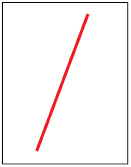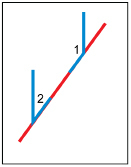Module 5
1. Module 5
1.28. Page 3
Module 5: Angles
Explore
In this activity you will review the relationships between co-interior and co-exterior angles formed when two parallel lines are intersected by a third line.
 Try This
Try This
Step 1: Draw a line on a blank sheet of paper. This line will serve as the transversal.

Step 2: On a second sheet of paper, draw a pair of adjacent supplementary angles similar to the angles shown here.

Do you remember why ∠1 and ∠2 are supplementary?
Step 3: Cut out ∠1 and ∠2 along the arms of the angles as shown.

Step 4: Position the angles along one side of the transversal, so that each angle has an arm that touches the transversal and the other two arms of the angles are parallel.

 Self-Check
Self-Check
SC 6. How many different ways can you arrange the angles you cut out to form parallel lines? Draw a diagram for each arrangement. For each arrangement, use the correct term you encountered in the previous lesson to describe each angle pair. For example, to describe the angle pair shown in Step 4, you could use the term co-interior.